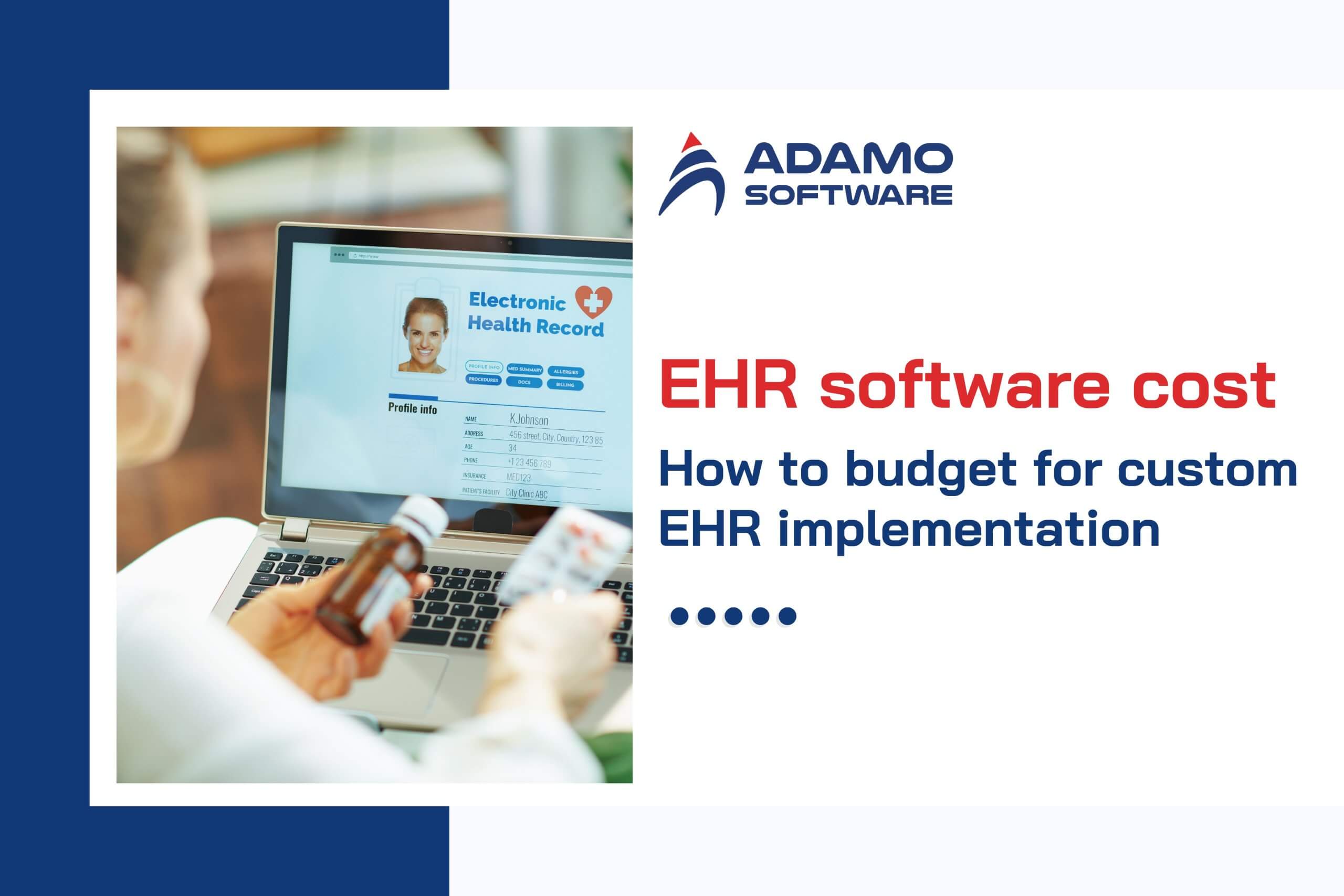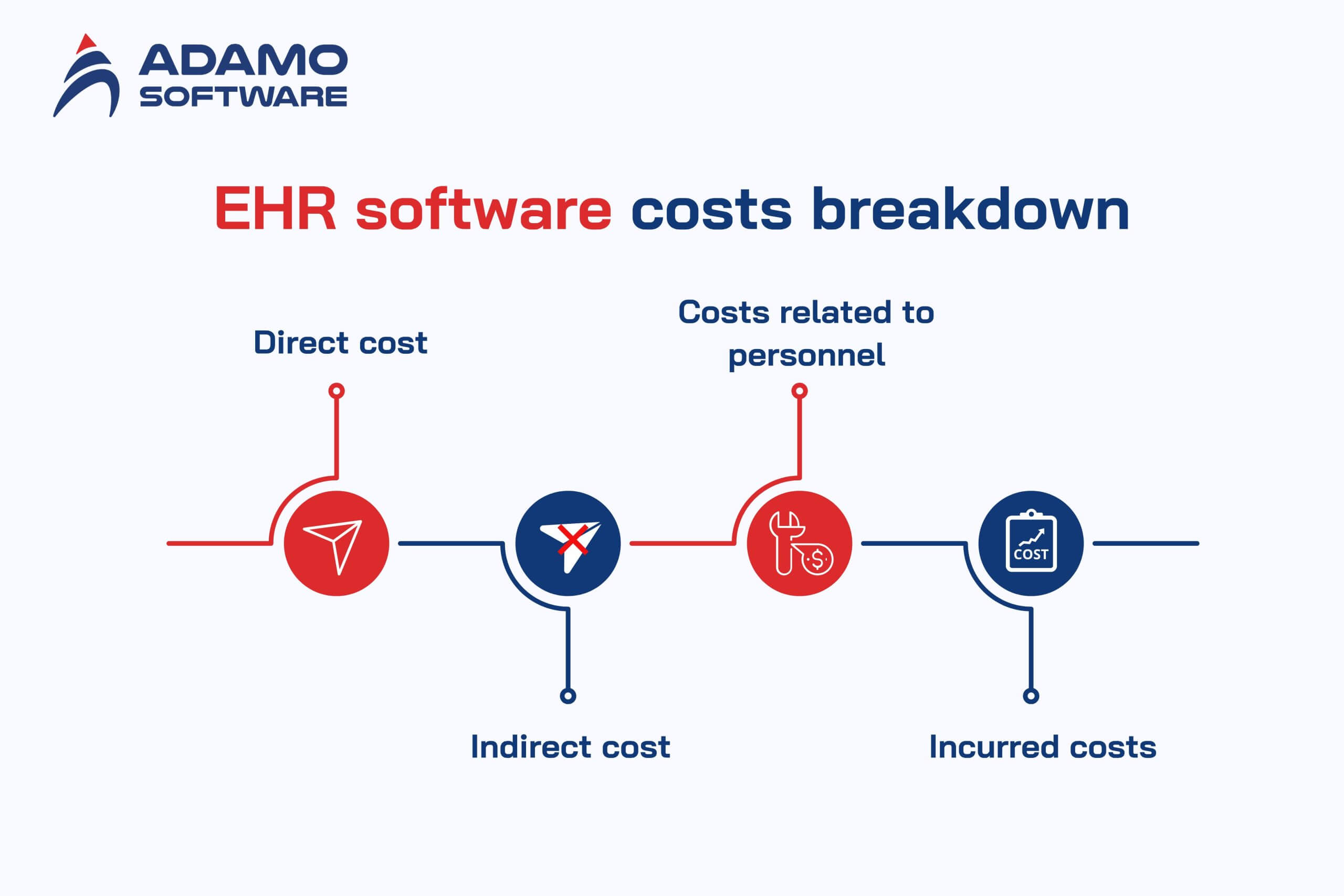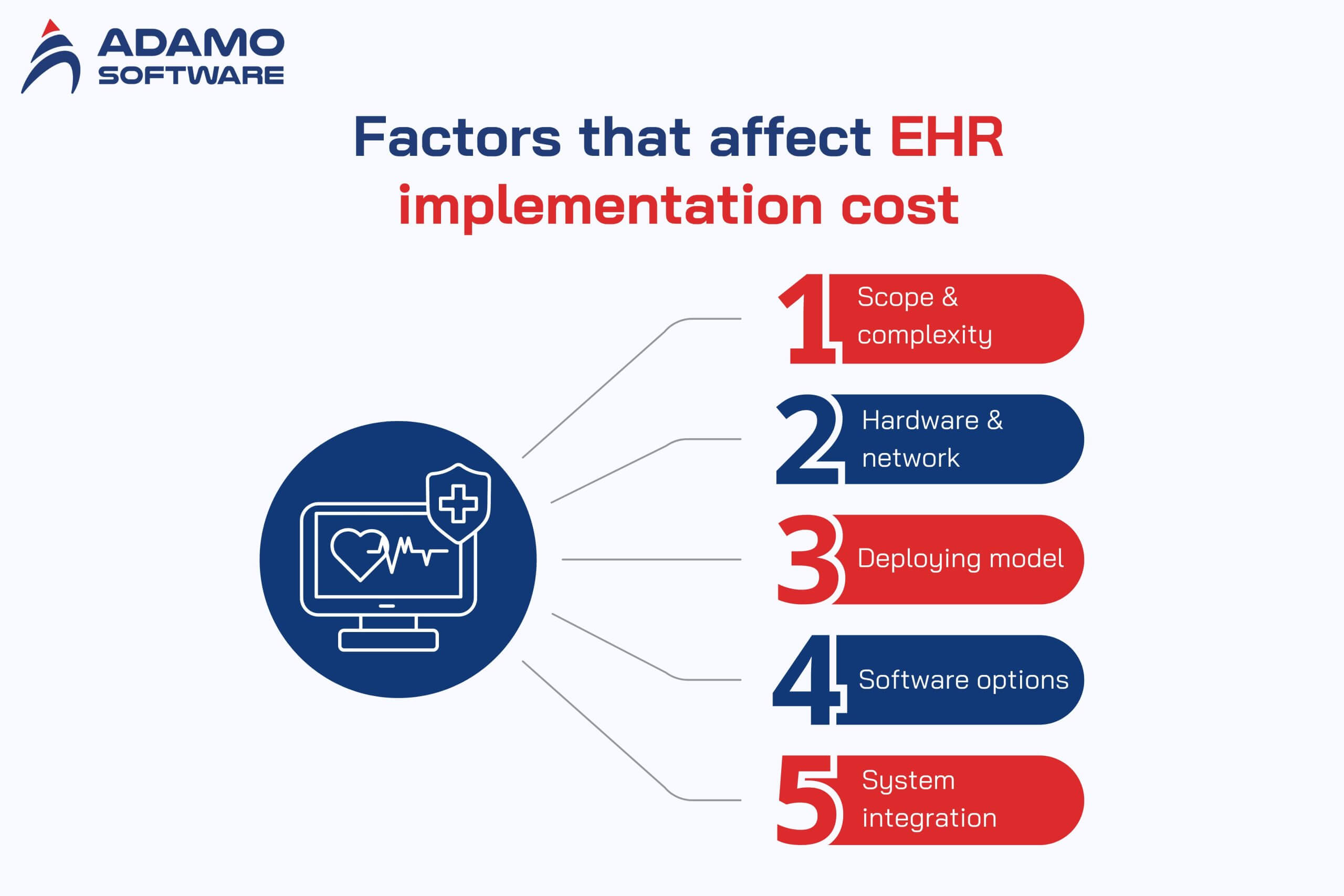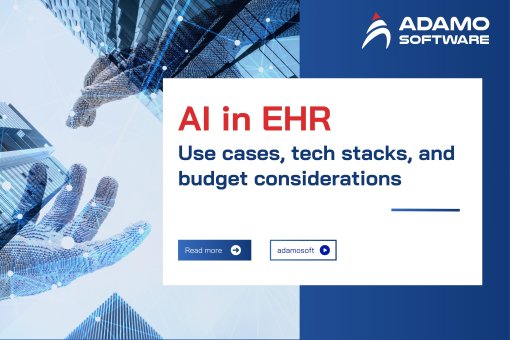EHR software cost: How to budget for custom EHR implementation

Electronic health record (EHR), a collection of an individual’s health data, is becoming more popular in healthcare facilities. EHR software allows medical facilities to monitor patient’s health status and diagnostic and treatment information while patients can view their health records. With such benefits, implementing EHR software is extremely necessary. One of the most important factors in developing the software is the EHR software cost. So, how do you budget for custom EHR implementation? Let Adamo Software answer this question.
Through this blog post, you will find a breakdown of the EHR software cost and factors that affect the cost. Besides, some hidden costs of the EHR software and tips to optimize the costs of EHR software will also be discussed. Finally, Adamo gives specific numbers on how much complete EHR software will cost. All information has been thoroughly researched and updated to the latest trends. So, let’s read our post and find yourself some useful pieces of information!
I. EHR software costs breakdown
One of the difficulties in implementing the EHR software is the EHR software cost. Here’s a breakdown of the costs so that you can plan your budget effectively when you develop your software.

1. Direct cost
The direct cost includes expenses directly related to software implementation. The cost of development and customization of the software is a significant EHR software cost, as this involves designing and programming processes to meet the medical facilities’ needs. Besides, you may want to note the system integration costs. These costs are invested in integrating your EHR software with existing platforms that the hospitals are using, such as Electronic Medical Records or hospital management systems.
Besides, you must consider the software licensing fees if using third-party solutions. Additionally, investments in hardware such as servers or storage devices to support system operations are also notable. These costs require detailed budget planning to ensure effective implementation and avoid resource shortages.
2. Indirect cost
Although the indirect EHR software cost is not directly related to software development, it significantly affects the total implementation cost. Firstly, the software maintenance cost is an indispensable cost that ensures your EHR software is always stable, and problems are quickly resolved. Next, you must also budget for the software upgrade costs. These costs allow you to update new features for your software and ensure compliance with the latest regulations.
In addition, costs related to IT infrastructure, such as network upgrades or enhanced data security, also affect the budget. Besides, the costs of changing working workflows when healthcare facilities need to adjust internal operations to accommodate the new EHR system are also outstanding expenses. Despite not being easily noticed at first, these costs have a big impact on long-term operational efficiency, requiring careful preparation from the medical facilities.
3. Costs related to personnel
When implementing the EHR software, you must also consider the costs related to personnel to plan your budget. Healthcare facilities must invest in recruitment costs. They may need to hire IT professionals or system administrators to ensure the smooth implementation and operation of the EHR. These personnel play an important role in maintaining, monitoring, and handling technical issues of the system.
Besides recruitment, the costs related to personnel also involve the cost of productivity disruption in the initial phase. The staff need time to become familiar with the new system, which can affect work efficiency. Additionally, you must consider the costs of training or further professional development for IT staff, to ensure they can maintain and improve the system in the future. These costs not only affect the immediate budget but also have a long-term impact on the operational efficiency of the EHR.
4. Incurred costs
The incurred costs in the EHR software cost are unpredictable but significantly impact on the total budget to implement the software. One of the most common costs is the cost of fixing problems, including system errors, service interruptions, or recovering data when unexpected problems occur. Besides, adjusting or changing workflows to accommodate the new EHR system can also increase costs, especially in large facilities with complex processes.
In addition, if your software must comply with new legal regulations or industry standards such as HIPAA or GDPR, you will have to invest in upgrading software or enhancing data security. Another factor is the cost associated with scaling the system as the business grows, such as adding users or upgrading IT infrastructure. These costs require you to be flexible in your budgets and have contingency plans to ensure that the implementation schedule is not affected.
Overall, no matter what type of EHR software costs, you still need to understand it clearly. By analyzing each item in detail, you can predict more accurately and avoid unexpected costs.
II. Factors that affect EHR implementation cost
The implementation of EHR software cost depends on different factors. When planning a budget for your EHR software, you must consider these key categories below.

1. Scope and complexity of the project
The scope and complexity of the project are among the significant factors that affect the implementation of the EHR software cost. The scope of the project decides the implementation scale, including the number of stakeholders. The wider the scope is, the more staff required, and the more data needed to be processed. This leads to increased costs from hardware, licensing to maintenance.
In terms of complexity, requirements to customize software to meet specific workflows or integrate with existing systems, such as EMRs or hospital management software, will increase development time and costs. Additionally, integrating advanced features such as automated patient record management, data analytics, or compatibility with medical devices also requires more complex engineering.
2. Hardware and network
When considering the implementation of EHR software cost, you must also focus on the hardware and network. IT facilities are important in deploying the software. If you need to upgrade servers, purchase additional data storage, or improve network connectivity to ensure performance, hardware and network costs will increase. If the data is too large, EHR implementations may require more robust networking.
3. Deploying model
Choosing the deploying model also impacts the EHR software cost. There are three common types of deploying models, including on-premises, cloud-based, and hybrid. The implementation expense of an EHR system can fluctuate considerably based on the selected deployment strategy. Using the on-premises model, you will have to invest in hardware, software, and human resources to manage the on-premises system, resulting in higher initial costs. Whereas for the cloud-based model, the initial costs will be lower. However, you will have to suffer recurring costs, such as usage fees and data storage. The hybrid model combines the above models, providing flexibility but can be expensive due to the requirement of both on-premises infrastructure and cloud services.
4. Software options (customization or off-the-shelf)
Software choice is also an important factor affecting the EHR software cost. The decision of whether to choose customized software or available software must be made based on the specific needs of the healthcare facilities.
- Custom EHR
Developing custom EHR software offers complete personalization to fit your specific business processes and needs. However, the initial cost is often higher due to the time and resources required for design, programming, and testing. This solution is suitable for large healthcare facilities with complex workflows.
- Off-the-shelf software
Off-the-shelf EHR software typically has lower initial costs and faster implementation times because it has already been developed and tested. Software vendors typically offer solution packages that include basic functionality, maintenance, and technical support. However, this solution may not be fully aligned with your specific business workflow, requiring additional costs to customize or integrate with your existing system.
Overall, choosing between these two solutions depends on the size, budget, and development goals of the medical centers. A detailed plan and expert advice will help make the most appropriate decision.
5. System integration ability
System integration ability also affects the EHR software cost. The EHR system may need to integrate with other systems such as EMRs, financial management software, hospital management systems (HIS), or laboratory management software (LIS). This requires development and testing costs to ensure that the data integrates with other systems such as EMRs, financial management software, hospital management systems (HIS), or laboratory management software (LIS).
Besides, the integration must ensure that the data is synchronized. This is especially important for managing patient records, treatment histories, and financial reporting. Complex data synchronization can add to costs by requiring advanced data management solutions. Additionally, integrating multiple systems increases data security risks. Therefore, you must invest more in encryption, user authentication, and vulnerability testing to comply with regulations such as HIPAA or GDPR.
III. Hidden costs of EHR software
The hidden costs of EHR software are those that are not apparent in the implementation plan or are not fully recognized when assessing the total initial cost. They are not unexpected costs but costs that are hard to see or often overlooked. Let’s find out the hidden costs of the EHR software cost with Adamo Software!
1. Changing management costs
When adopting the EHR system, you must change the operating process to be suitable for your new systems. This requires time and effort from both management and employees, resulting in costs associated with change management and lost opportunities from temporary productivity losses.
2. The cost of long-term integration
The cost of long-term integration is also a hidden EHR software cost. Although the initial integration has been planned, the ongoing costs of maintaining or expanding integration with other systems are often not fully realized. When an EHR system or other integrated software is upgraded, you will need to modify or upgrade your connection interfaces (APIs). This is not anticipated during the planning phase and may require additional engineering resources.
Besides, as technology rapidly evolves, new healthcare systems or medical devices may require additional integration into the EHR. This requires costs for developing, testing, and implementing new integrations.
3. The cost of regulatory changes
The cost of regulatory changes is a significant EHR software cost. This arises from increasingly stringent healthcare and data privacy regulations. These changes can come from domestic or international regulatory agencies, requiring healthcare facilities to adjust their systems to ensure compliance and avoid legal and financial risks. Here are some factors that have caused the increase in this cost.
- Upgrading security system
Regulations like HIPAA (in the US), GDPR (in the EU), or similar national standards may require medical facilities to enhance security standards. Therefore, you must invest in data encryption, penetration testing, and other data protection solutions.
- Improving data storage and access
Some regulations require healthcare facilities to store patient data for a certain period or ensure that data can be accessed quickly. This requires upgrading storage infrastructure or improving system processing speed.
- Testing and certification costs
Testing and certification costs also increase the cost of regulation changes in the EHR software cost. To ensure that the system meets new requirements, you may have to conduct periodic testing or obtain necessary certifications, which can come with significant costs.
4. Data migration
Data migration is also among the hidden costs of the EHR software cost. This cost is normally not planned in the initial budgets as healthcare facilities just focus on software and training costs. This leads to miscalculation or misestimation of costs. The new EHR system may not be compatible with existing systems of healthcare facilities in terms of data formats, storage standards, or database structures. his requires custom data conversion tools or hiring experts, resulting in unforeseen costs.
Overall, the hidden costs of the EHR software cost are often not fully identified during the planning phase. Understanding and planning for these costs will help you optimize your budgets, minimize financial risks, and ensure the EHR system operates effectively in the long term.
IV. Tips to optimize costs of EHR software
To manage your EHR software cost effectively, you may want to have optimized strategies to ensure the expected results. Below are some tips to optimize the costs of EHR software!

1. Choosing suitable solutions for your needs
Before implementing your EHR software, you must carefully evaluate the size, scope of operations, and specific requirements to choose the right EHR software and optimize your EHR software cost. This helps you avoid wasting your budget on unnecessary features and ensure the EHR system provides maximum support for operational activities.
For small medical centers, a simple, low-cost EHR system may be sufficient. For large hospitals or complex medical organizations, it is necessary to choose software that is scalable and supports large-scale data management. You must identify the main features of your EHR software, such as manage medical records, schedule appointments, and track treatment history.
2. Prioritizing flexible and scalable software
Choosing a flexible and scalable system plays a key role in managing your EHR software cost effectively. Flexibility and scalability enable you to save on upgrade costs and ensure long-term compatibility as requirements change. You may want to choose software that complies with standards like HL7 or FHIR, which makes it easy to integrate with other healthcare systems and reduces future customization costs.
Besides, let’s prioritize solutions that can increase storage capacity, handle more users, or add new features without replacing the entire system. This is especially important if you want to expand operations or increase patient volumes in the future.
Overall, a flexible and scalable system helps you optimize your EHR software cost and boost long-term development of the healthcare facilities. This ensures savings and efficiency in the future.
3. Planning for hidden costs in the long term
An effective strategy for managing EHR software cost is to anticipate and plan for hidden costs. As mentioned, these costs are normally ignored by the healthcare facilities. You must identify potential hidden costs including long-term integration costs, changing regulatory requirements, routine maintenance, and software upgrades, etc.
Then, it is highly recommended that you set aside a fixed budget to handle unforeseen costs, ensuring financial stability when they arise. This budget should be 10-15% of the total cost of implementing an EHR system.
4. Negotiating with suppliers
Negotiating with suppliers is essential in controlling your EHR software costs. This helps you decrease initial expenses and long-term operational costs. Besides, you can minimize risks from unexpected costs and get optimal support and maintenance terms. Working with the suppliers, you must make sure that they provide a clear quote that lists each cost item, from development and implementation to maintenance and support. In addition, let’s ask the providers to include maintenance, software upgrades, or technical support in your contract to save on additional costs.
Additionally, let’s plan regular cost monitoring to ensure that any hidden costs are controlled and addressed promptly. You can use financial management software to support if needed.
In general, optimizing your EHR software cost helps you save money and increase the value of the system. If you want to achieve long-term efficiency, you must have an effective cost management strategy.
Also read: How to build an EMR system: A step-by-step guide
V. How much does a custom EHR software cost?
The custom EHR software cost can vary greatly, depending on many factors such as project size, feature requirements, and level of integration. Here are the key cost items to consider when implementing.
1. Analyzing and planning costs
The analyzing and planning costs in the custom EHR software cost include requirements survey, process analysis and development planning. The expense ranges from USD 5,000 to USD 20,000 depending on project complexity.
2. UX/ UI design
The UX/ UI design is also an important cost in the tailored EHR software cost. To create an interface that is user-friendly and suitable for health organization procedures, it costs you from USD 10,000 to USD 30,000, depending on the detail and level of customization.
3. Software development
Software development is the largest expense in the personalized EHR software cost. It includes coding, developing features like records management, scheduling, medical device integration, etc. Depending on the size and requirements of the system, you will have to spend from USD 50,000 to USD 300,000.
4. Integration with existing systems
You may want to integrate your EHR software with existing systems such as HIS, LIS, or PACS. Costs can range from $10,000 – $50,000, depending on the level of compatibility and customization required.
5. Implementation and installation costs
The implementation and installation include software installation, system configuration, and data migration from legacy system. The estimated EHR software cost for these costs ranges from USD 5,000 to USD 20,000.
6. Maintenance and technical support costs
The maintenance and technical support involve regular maintenance, troubleshooting, and feature upgrades. It typically accounts for 15-20% of annual implementation costs, approximately USD 10,000 – USD 50,000/year.
7. Future upgrade and expansion costs
The future upgrade and expansion process involves adding new features, expanding the system. These costs are difficult to estimate accurately but are often included in long-term budgets.
Overall, the total cost of implementing custom EHR software is usually between $100,000 – $500,000 or more, depending on the size and specific requirements of the business. Detailed planning and cooperation with a trusted development partner will help businesses optimize costs, while ensuring the EHR system is effective in the long term.
VI. How Adamo can support your business with EHR implementation
As one of the leading technology companies in Vietnam, Adamo Software can be your trusted partner in deploying your EHR software. Here’s how Adamo can help you optimize your EHR software cost.

1. Providing custom EHR software solution
We offer customized EHR solutions that fit the unique needs of every healthcare organization, from large hospitals to small clinics. These software solutions are designed to optimize workflow, improve the efficiency of medical records management, and minimize treatment errors.
2. Integrating EHR software with existing systems
We support the integration of EHR systems with existing software and technologies in the enterprise, such as HIS (Hospital Information System), LIS (Laboratory Information System), and other medical devices. Compared to implementing a completely new system, this can help you save time and EHR software cost.
3. Security and compliance support
Adamo ensures that the EHR software meets security standards such as HIPAA and legal requirements in the healthcare industry. This helps protect patient information and ensure regulatory compliance, minimizing legal risks for the healthcare facilities.
4. Optimizing EHR software cost
We understand the factors that affect EHR software cost. By providing flexible, scalable, and customizable solutions, we can help you save costs throughout the process of implementing and using EHR software.
Still hesitate whether to choose Adamo Software for your EHR software implementation? Let’s contact us for more detailed information.
FAQs
1. What is the typical price range for EHR systems in small medical practices?
The expense of implementing an EHR system in a small practice can fluctuate. Generally, small practices may allocate between $10,000 and $50,000 for initial setup, encompassing software, hardware, and training.
2. What is the total cost of implementing EHR software?
The cost of implementing an EHR can vary widely, from $100,000 to $500,000, depending on many factors. They are project scope, healthcare size, custom features, degree of integration with other systems, etc.
3. Is the EHR software cost of maintenance expensive?
Maintenance costs typically account for 15-20% of the total annual implementation cost. This includes troubleshooting technical issues, updating software, upgrading security to meet new standards, etc.
4. What strategies can be employed to effectively budget for EHR implementation?
To effectively budget for EHR implementation, consider both initial and ongoing expenses. This includes software and hardware costs, training, and potential unforeseen costs like data migration and system integration.
5. Should you invest in cloud-based EHR software?
Cloud-based EHRs are often more cost-effective than on-premises. There is no hardware investment required, and the maintenance and upgrade costs are lower. However, healthcare facilities need to ensure that the cloud system meets healthcare data security standards.











